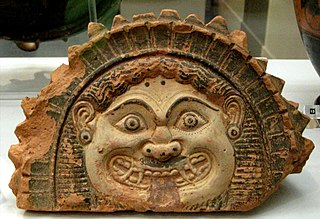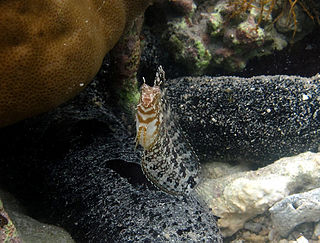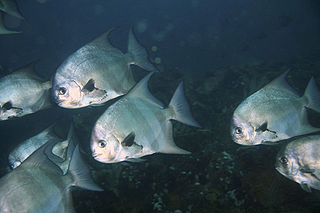
Anthozoa is a class of marine invertebrates which includes the sea anemones, stony corals and soft corals. Adult anthozoans are almost all attached to the seabed, while their larvae can disperse as part of the plankton. The basic unit of the adult is the polyp; this consists of a cylindrical column topped by a disc with a central mouth surrounded by tentacles. Sea anemones are mostly solitary, but the majority of corals are colonial, being formed by the budding of new polyps from an original, founding individual. Colonies are strengthened by calcium carbonate and other materials and take various massive, plate-like, bushy or leafy forms.

In Greek mythology, Medusa, also called Gorgo, was one of the three Gorgons. Medusa is generally described as a human female with living venomous snakes in place of hair; those who gazed into her eyes would turn to stone. Most sources describe her as the daughter of Phorcys and Ceto, although the author Hyginus makes her the daughter of Gorgon and Ceto.

Combtooth blennies are blenniiformids; percomorph marine fish of the family Blenniidae, part of the order Blenniiformes. They are the largest family of blennies with around 401 known species in 58 genera. Combtooth blennies are found in tropical and subtropical waters in the Atlantic, Pacific and Indian Oceans; some species are also found in brackish and even freshwater environments.

Labrisomids are small blennioids (blennies), percomorph marine fish belonging to the family Labrisomidae. Found mostly in the tropical Atlantic and Pacific Ocean, the family contains about 110 species in 15 genera.

The blennioid family Chaenopsidae includes the pike-blennies, tube-blennies, and flagblennies, all percomorph marine fish in the order Blenniiformes. The family is strictly tropical, ranging from North to South America. Members are also present in waters off Japan, Taiwan and Korea. Fourteen genera and 90 species are represented, the largest being the sarcastic fringehead, Neoclinus blanchardi, at 30 cm (12 in) in length; most are much smaller, and the group includes perhaps the smallest of all vertebrates, Acanthemblemaria paula, measuring just 1.3 cm (0.51 in) long as an adult.

Blenny is a common name for many types of fish, including several families of percomorph marine, brackish, and some freshwater fish sharing similar morphology and behaviour. Six families are considered "true blennies", grouped under the order Blenniiformes; its members are referred to as blenniiformids. About 151 genera and nearly 900 species have been described within the order. The order was formerly classified as a suborder of the Perciformes but the 5th Edition of Fishes of the World divided the Perciformes into a number of new orders and the Blenniiformes were placed in the percomorph clade Ovalentaria alongside the such taxa as Cichliformes, Mugiliformes and Gobiesociformes.

The grunt sculpin or grunt-fish is a small fish mainly found in the eastern Pacific Ocean. The grunt sculpin generally remains close to shore and is often found in empty giant barnacle shells. The common name comes from reports that the fish vibrate or "grunt" when held. Its defining feature is its tendency to “hop” along the ocean floor on its orange fins. The short, stout body of the grunt sculpin has a long, small mouth which is adapted for eating smaller prey.

The Kapala stingaree is a species of stingray in the family Urolophidae, endemic to inshore waters off southeastern Queensland and New South Wales. It is commonly found on and around rocky reefs at a depth of 10–130 m (33–427 ft). Reaching 51 cm (20 in) in length, the Kapala stingaree has a rounded, diamond-shaped pectoral fin disc and a slender tail, which ends in a leaf-shaped caudal fin and bears lateral skin folds and a small dorsal fin in front of the stinging spine. It has a distinctive bell-shaped curtain of skin between its nostrils. This species is greenish above, with a highly variable pattern of dark markings usually found outside and between the eyes, and over the back and tail.

The greater amberjack, also known as the allied kingfish, great amberfish, greater yellowtail, jenny lind, Sea donkey, purplish amberjack, reef donkey, rock salmon, sailors choice, yellowtail, and yellow trevally, is a species of predatory ray-finned fish in the family Carangidae, the jacks and pompanos. It is found in temperate, subtropical, and tropical seas around the world. It is a popular quarry species for recreational fisheries and is important in commercial fisheries. It is the largest species in the family Carangidae.

Coastal fish, also called inshore fish or neritic fish, inhabit the sea between the shoreline and the edge of the continental shelf. Since the continental shelf is usually less than 200 metres (660 ft) deep, it follows that pelagic coastal fish are generally epipelagic fish, inhabiting the sunlit epipelagic zone. Coastal fish can be contrasted with oceanic fish or offshore fish, which inhabit the deep seas beyond the continental shelves.
Ophioblennius trinitatis is a species of combtooth blenny endemic to the southwest Atlantic ocean. It is a subtropical marine fish commonly found in reefs off the coast of Brazil. Combtooth blennies are often referred to as "peixes-macacos" in Brazil, which translates to "monkey-fish".

Petroscirtes is a genus of combtooth blennies found in the western Pacific, and Indian oceans. Some species of this genus have venom that interacts with opioid receptors. Adults usually inhabit coastal reefs and estuaries to depths of about 10 meters, but they can also be found up to 15 meters in depth in sandy and weedy areas among clumps of Sargassum or other seaweeds in coastal and lagoon reefs. They can be found in nests inside small-necked bottles and abandoned worm tubes or shells.

Ecsenius trilineatus, known commonly as the three-lined blenny in Australia, and the white-spotted comb-tooth or the white-spotted combtooth blenny in Indonesia, is a species of combtooth blenny in the genus Ecsenius. It is a non-migoratory species of blenny found in coral reefs in the western central Pacific ocean. It can reach a maximum length of 3 centimetres. Blennies in this species feed primarily off of plants, including benthic algae and weeds, and are commercial aquarium fish, but of no interest in fisheries.

Acanthemblemaria balanorum, the clubhead blenny or clubhead barnacle blenny, is native to the eastern Pacific Ocean, where it occurs from the Gulf of California along the coast of Mexico south to Colombia and Ecuador.

Acanthemblemaria castroi, the Galapagos barnacle blenny, is a species of chaenopsid blenny endemic to coral reefs in the Galapagos Islands, in the southeast Pacific ocean. It can reach a maximum length of 6 cm (2.4 in) TL. The specific name honours a naturalist at the Charles Darwin Foundation, Academy Bay, Santa Cruz Island, Galápagos, Miguel Castro.

Acanthemblemaria maria, the secretary blenny, is a species of chaenopsid blenny found in shallow seas in the western central Atlantic Ocean and the Caribbean Sea. It can reach a maximum length of 5 cm (2.0 in) TL.

Acanthemblemaria stephensi, the Malpelo barnacle blenny, is a species of chaenopsid blenny found in coral reefs around Malpelo Island, in the eastern Pacific ocean. It can reach a maximum total length of 5 cm (2.0 in). This species feeds primarily on zooplankton. The specific name honours the environmental biologist John S. Stephens Jr.

Megabalanus tintinnabulum is a species of large barnacle in the family Balanidae. It is the type species of the genus. The specific name comes from the Latin tintinnabulum meaning a handbell and probably refers to the fact that small groups of barnacles resemble clusters of miniature bells.

The Pacific spadefish is a species of fish of the family Ephippidae. It is native to the eastern Pacific, from San Diego, California to Peru, including is the Galápagos Islands where it is known as Chambo.



















